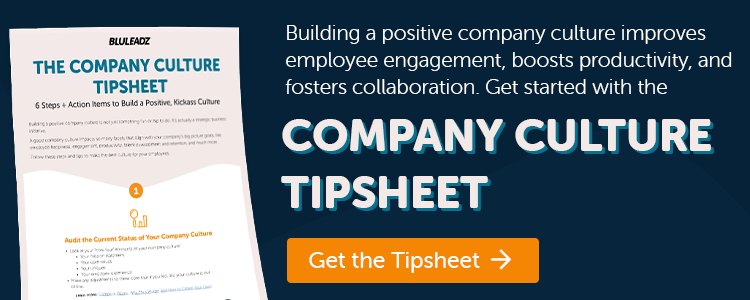Company culture is one of the most important factors that differentiates employers in today’s ultra-competitive job market. Skilled employees know that they’re in demand, and they know what they want: a culture that facilitates their best work in every way possible.
Fostering the right culture helps you connect with key talent and keep your HR efforts on track.
It’s also essential for Millennials and the upcoming Generation Z. A challenging yet supportive environment will be attractive to younger employees looking to make their mark.
Company culture is made up of all the spoken and unspoken rules, norms and practices that take place inside your company, influencing how co-workers relate and how they do their jobs. It’s the water you swim in all day, every day – and it better not be polluted!
The wrong corporate culture can tank you, but the right one is a competitive advantage your market rivals can’t duplicate. So, how can you capture lightning in a bottle and make your culture work as hard as you do?
The First Thing to Remember: Culture is Infectious
Your company culture is something everyone experiences all the time, but it starts at the top.
In digital marketing, we know that what you don’t measure, you can’t manage. Of course, your culture is qualitative – you wouldn’t be able to measure it with a ruler, but you can see it through its effects. It all starts by having concrete goals for the culture you want.
Just like moving to another country, people take cultural cues from those around them. And workers, at whatever level, take their first cues from their managers ... who get it from their managers ... and so on. (Senior executives, of course, bring a lot of culture with them.)
So, a good culture starts with clear company values everyone understands. When you have values to guide you, you can always stop to check any practice, policy, or process against them.
To learn more about defining, crafting, and sharing those values, check out How to Craft the Perfect Core Values for Your Business.
Get Others Involved, Interested, and Invested
Culture starts at the top, but it doesn’t stay there.
Just like a fancy B2B business solution, your culture won’t do much for you if nobody actually adopts it. Your team is much more likely to carry your culture through the day if they help formulate it.
Your company’s values might come from your leadership team, but values are only one half of the culture equation – just like executives themselves.
To come down to earth, those values need to translate into practices, and it’s your team members who can make that happen.
The best way: Have an all-hands meeting where you go through your company’s values one by one and take suggestions about how each can translate into daily actions. Write the suggestions and let the group come to a consensus on which ones to take on board.
Then, make sure those action items are there for people to see. Actions have to become habits before they can really crystallize into culture. With that in mind, you need all of these things to come from your all-hands cultural confab:
- Three to six ways everyone will work every day to make your company culture a reality.
- An open, honest approach to ongoing communication about your company’s culture.
- A plan to meet up after a month or so to share observations and brainstorm solutions.
- A high-impact visual reminder of the cultural touchstones your team committed to.
Like any part of your business, your culture and the practice surrounding it will need some troubleshooting – not to mention continuous improvement. These points provide the tools you need.
Start Your Morning with the Mantra “Be World Famous”
One of the greatest examples of an infectious company culture comes from the “world famous” Pike Place Fish Market in Seattle, Washington.
For more than 20 years, the business barely got by – ending up on the brink of bankruptcy. A decision to change the culture saved everything.
The goal: to be “world famous.”
Not to become world famous, but to act as if the Fish Market was already the best business of its kind. What it meant for the culture: being playful and enjoying work, so customers would always enjoy spending time at the Fish Market, too.
It worked.
After four years of sticking to the attitude Pike Place wanted to reflect in the world, it really did become world famous during the 1990 Goodwill Games. News crews were fascinated by this team of friendly, fast-moving fish lovers known for hurling customers’ orders around the store.
The lesson: Your culture should be driven by your aspirations, not just the day-to-day grind of business demands. In psychology, this is called anticipatory role behavior, the idea that if you act as if something will come to pass, you align your behavior, thoughts and expectations.
It works the same way in a group; pick a moonshot goal for the way you want your team to be, and reinforce that goal every day with visual reminders that every team member can see.
For example, some businesses that want to connect with customers on a deeper level have filled common areas with actual photos of those customers, a few words of their stories and perhaps a testimonial or two. That keeps the real customer in mind, and the whole culture flows from that.
No matter your company culture, think of easy reminders to stoke excitement and momentum.
Recruit for Cultural Fit, Too

A quick word on HR’s role. Once your culture starts to emerge in all its brilliance, be sure hiring decision-makers have the resources they need to vet candidates based on that fit.
Google, Apple, and many others diligently seek out candidates that reinforce their core cultural values. It not only keeps new hires happier, but leads to higher productivity and lower turnover.
What’s the most important part of your company culture? Spill the details below!


Rob Steffens
I am the Director of Marketing here at Bluleadz. I'm a huge baseball fan (Go Yankees!). I love spending time with friends and getting some exercise on the Racquetball court.